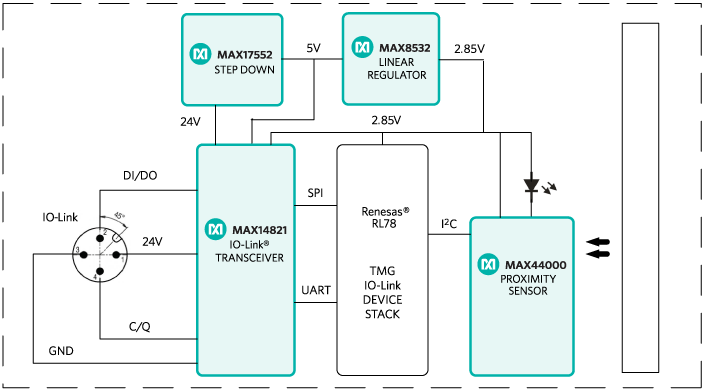Today's factories are increasingly dependent on automation and less and less dependent on manual labor. As the use of robots becomes more common, there is a growing need for proximity detection. Proximity detection sensors can detect objects within a certain distance from the reference point. The device flips to function as a switch when the target object passes a predefined distance threshold, or it can provide continuous readings as the object moves within the range of the sensor. There are many types of proximity detection sensors available today, such as optical, inductive, capacitive, ultrasonic, magnetic and even mechanical sensors. Some applications have special requirements that make certain types of sensors more suitable than others. Thanks to the rapid development of optoelectronic technology, light sensors have great versatility. This versatility enables it to meet a wide range of industrial proximity detection needs1 , including detection of magnetic or non-magnetic objects, extremely small objects, ultra-long distances, and fast response times.
Factories also tend to use widely accepted industrial protocols. IO-Link is the first open, fieldbus-agnostic, low-cost, point-to-point serial communication bus protocol for communicating with sensors and actuators that has been adopted as an international standard (IEC 61131-9) 2 . IO-Link finally standardized the interoperability of industrial equipment around the world. IO-Link can be operated directly from a PLC or integrated into any standard fieldbus, making it quickly becoming the de facto standard for communicating with smart devices such as the MAXREFDES27#. Both simple and smart, IO-Link enables the industry's smallest low-cost smart sensors.
MAXREFDES27# is a tiny IO-Link proximity sensor with an IR receiver, accompanying IR LED driver, IO-Link transceiver and high-efficiency buck converter, all mounted on an 8.2mm x 31.5mm printed circuit (PC) board superior. Maxim Integrated and Technologie Management Gruppe Technologie und Engineering (TMG TE) collaborated to design MAXREFDES27# as a proximity detection sensor reference design compatible with version 1.1/1.0 of the IO-Link protocol. The MAXREFDES27# design includes industry-standard Maxim Integrated IO-Link device transceiver (MAX14821); tiny low-dropout linear regulator (MAX8532); high-efficiency, high-voltage, step-down converter (MAX17552); IO using TMG TE -Link Device Stack's Renesas ultra-low-power, 16-bit microcontroller (RL78), Maxim Integrated proximity sensor (MAX44000). Figure 1 shows the system block diagram.

Figure 1. MAXREFDES27# reference design block diagram.
Micro Industrial Sensor Specifications
Ultra-low power consumption 150mW
low cost
IEC 61131-9
Compatible with IO-Link versions 1.1 and 1.0
Fieldbus agnostic
Transient voltage suppression
Reverse polarity and short circuit protection
encapsulation
Material handling
food processing
roller coaster
production line
Conveyor system
robot
process control

All reference designs on this site are sourced from major semiconductor manufacturers or collected online for learning and research. The copyright belongs to the semiconductor manufacturer or the original author. If you believe that the reference design of this site infringes upon your relevant rights and interests, please send us a rights notice. As a neutral platform service provider, we will take measures to delete the relevant content in accordance with relevant laws after receiving the relevant notice from the rights holder. Please send relevant notifications to email: bbs_service@eeworld.com.cn.
It is your responsibility to test the circuit yourself and determine its suitability for you. EEWorld will not be liable for direct, indirect, special, incidental, consequential or punitive damages arising from any cause or anything connected to any reference design used.
Supported by EEWorld Datasheet